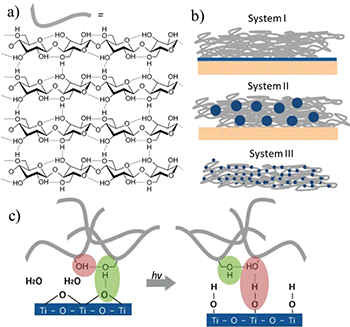Authors: Ulasevich S.A., Inga Melnyk, Daria V. Andreeva, Helmuth Möhwald,

EPL (Europhysics Letters), 2017, 119 (3), pp 38003 (1-6)
Abstract
In an effort to control the electronic and mechanical interaction between an inorganic surface and a defined polymeric coating, we present a new and easy method of a cellulose-based hybrid formation. We used Schweizer's reagent, a specific copper ammonia hydroxide-based solvent for cotton dissolution and found the optimal concentration for the formation of photosensitive uniform cellulose coating on titania, TiO2-cellulose coating and free-standing hybrid. Photomobility, the material mobility induced by light, of a cellulose layer on a titania surface and of a TiO2-cellulose hybrid on a silicon wafer has been studied. This can be used for photohealing, and the most promising system is the one that can be healed with light due to in situ activation of titania nanoparticles assembled on cellulose fibers in a hydrogel. The interfacial contact between titania particles and fiber is important for local transport of electrons and ions, thus the most promising system was obtained by in situ synthesis of titania nanoparticles on cellulose dispersed in Schweizer's reagent. We propose that cellulose coatings on titania surface and free-standing hybrids can be applicable for a wide range of photochemical devices: films for optics, drug delivery systems, and inks for printing of biologically relevant lab-on-chips.
DOI: 10.1209/0295-5075/119/38003
Read Full:
https://iopscience.iop.org/article/10.1209/0295-5075/119/38003